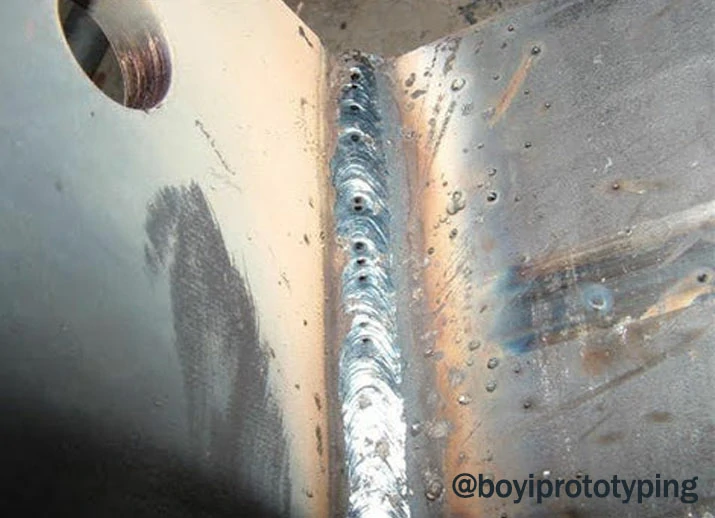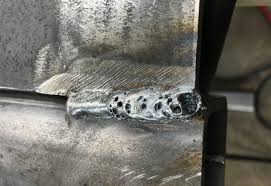Deciphering the Enigma of Porosity in Welding: Tips for Reducing Issues and Making Best Use Of Quality
In the intricate world of welding, porosity remains a persistent challenge that can significantly affect the high quality and stability of bonded joints. As we dig right into the midsts of porosity in welding, discovering the tricks to its prevention and control will be vital for experts looking for to understand the art of high-quality weldments.
Understanding Porosity in Welding
Porosity in welding, a common issue encountered by welders, describes the visibility of gas pockets or gaps in the bonded product, which can jeopardize the stability and high quality of the weld. These gas pockets are normally caught during the welding process due to various factors such as inappropriate securing gas, polluted base materials, or incorrect welding parameters. The development of porosity can damage the weld, making it prone to fracturing and deterioration, inevitably bring about architectural failures.
Understanding the source of porosity is essential for welders to efficiently stop its event. By recognizing the importance of preserving appropriate gas shielding, ensuring the sanitation of base materials, and optimizing welding setups, welders can substantially reduce the chance of porosity formation. Additionally, making use of techniques like pre-heating the base material, using proper welding strategies, and carrying out thorough assessments post-welding can even more assist in reducing porosity issues. Generally, a comprehensive understanding of porosity in welding is necessary for welders to create high-grade and resilient welds.

Common Root Causes Of Porosity
When inspecting welding procedures for potential high quality concerns, understanding the typical reasons for porosity is crucial for maintaining weld stability and stopping architectural failings. Porosity, identified by the visibility of cavities or spaces in the weld steel, can significantly compromise the mechanical homes of a welded joint. One common source of porosity is improper protecting gas protection. Insufficient protecting gas circulation prices or incorrect gas blends can bring about climatic contamination, causing porosity development.
An additional prevalent root cause of porosity is the visibility of dampness and pollutants on the surface of the base metal or filler product. When welding products are not appropriately cleaned up or are subjected to high levels of moisture, the evaporation of these contaminants throughout welding can develop gaps within the weld grain. Furthermore, welding at inappropriate specifications, such as excessively high traveling rates or currents, can create too much disturbance in the weld pool, trapping gases and causing porosity. By resolving these typical causes through correct gas protecting, material prep work, and adherence to optimal welding criteria, welders can lessen porosity and enhance the top quality of their welds.
Methods for Porosity Avoidance
Executing reliable safety nets is essential in decreasing the occurrence of porosity in welding processes. One strategy for porosity prevention is making sure correct cleaning of the base metal prior to welding. Impurities such as oil, grease, rust, and paint can bring about porosity, so complete cleaning utilizing ideal solvents or mechanical methods is crucial.

Another secret precautionary action is the selection of the best welding consumables. Utilizing high-quality filler materials and protecting gases that are appropriate for the base steel and welding process can significantly lower the risk of porosity. Additionally, preserving appropriate welding specifications, such as voltage, existing, take a trip rate, and gas circulation price, is essential for porosity avoidance. Differing the recommended settings can result in improper gas coverage and inadequate fusion, resulting in porosity.
Furthermore, employing correct welding strategies, such as preserving a constant travel speed, electrode angle, and arc size, can aid stop porosity (What is Porosity). Appropriate training of welders to ensure they follow ideal techniques and top quality control procedures is also essential in reducing porosity problems in welding

Best Practices for Quality Welds
One trick method is preserving correct cleanliness in the welding location. Thoroughly cleaning the work surface and bordering area before welding can aid alleviate these problems.
Another advice finest practice is to very carefully pick the proper welding specifications for the particular products being signed up with. This consists of setting the correct voltage, present, take a trip speed, and shielding gas flow price. Correct parameter choice makes certain ideal weld infiltration, fusion, and general top quality. Utilizing high-grade welding consumables, such as electrodes and filler steels, can considerably affect the last weld quality. Purchasing premium consumables can lead to more powerful, more long lasting welds with less issues. By adhering to these ideal methods, welders can constantly produce premium welds that satisfy market standards and exceed customer expectations.
Significance of Porosity Control
Porosity control plays an important function in making sure the stability and high quality of welding joints. Porosity, defined by the presence of cavities check my site or gaps within the weld steel, can dramatically compromise the mechanical residential or commercial properties and structural integrity of the Check This Out weld. Too much porosity weakens the weld, making it much more at risk to breaking, deterioration, and total failing under operational lots.
Efficient porosity control is important for keeping the desired mechanical residential or commercial properties, such as stamina, ductility, and toughness, of the welded joint. What is Porosity. By decreasing porosity, welders can enhance the general quality and dependability of the weld, making certain that it meets the efficiency needs of the intended application
Moreover, porosity control is vital for accomplishing the wanted aesthetic appearance of the weld. Extreme porosity not just weakens the weld but likewise takes away from its visual charm, which can be important in industries where looks are necessary. Proper porosity control strategies, such as making use of the appropriate protecting gas, managing the welding parameters, and guaranteeing proper tidiness of the base materials, are important for creating high-quality welds with minimal flaws.

Final Thought
To conclude, porosity in welding is a common problem that can jeopardize the top quality of the weld. By recognizing the sources of porosity and executing appropriate avoidance methods, welders can decrease issues and achieve higher quality welds. It is necessary to manage porosity in welding to make sure the stability and stamina of the last item. Carrying out finest methods for porosity control is vital for attaining optimum welding outcomes.